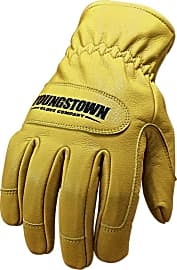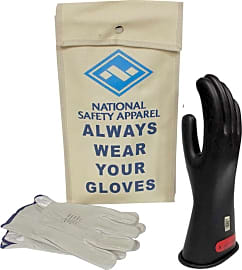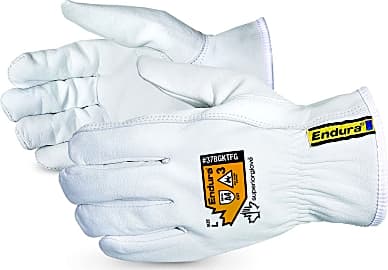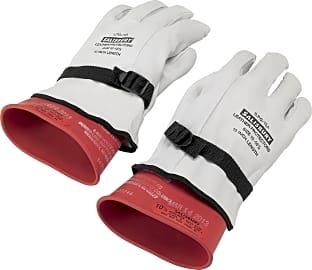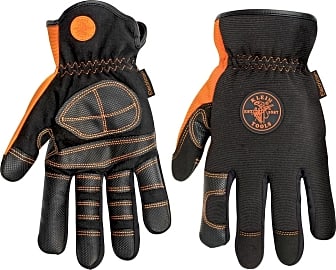The 10 Best Electrician Gloves

This wiki has been updated 35 times since it was first published in January of 2017. For electricians, a job site is an inherently dangerous place with the potential for injuries such as burns, shocks, puncture wounds, and more. Whether you’re a licensed professional or a DIYer tackling some home improvement projects, quality gloves are your first line of defense against these hazards. Make sure to look for a pair that fits not only your hands, but also your safety requirements. When users buy our independently chosen editorial recommendations, we may earn commissions to help fund the Wiki.
Editor's Notes
December 04, 2020:
Contact with an electrical current is one of the leading causes of occupational injuries and fatalities. To reduce the number of accidents, the Occupational Safety and Health Administration (OSHA) recommends wearing leather protectors with rubber insulators. The rubber insulator provides shock protection. Generally, they are rated from Class 00 for low voltage tasks up to Class 4 for high voltage jobs. Leather protectors shield the hands from cuts and abrasions. Some electricians prefer to add a liner when working outdoors in the cold. Usually, these gloves have a straight cuff or knit wrists and are thin enough to slide inside the rubber gloves.
While the previous list offered desirable options, a few picks were best suited for construction work and carpentry tasks. Since we already have dedicated space to cut proof styles and impact reducing options, we removed gloves that were not designed to offer some form of protection for electrical-related tasks. And while no one pair of gloves is suitable for every situation, this time around we focused on options better suited for handling different levels of electrical exposure.
First, we added the Klein Tools 40072. Although these gloves are not suitable for working with live wires, they provide the gripping ability needed for routing cables through walls. Also, we added options for low voltage tasks like the Salisbury GK0011R and choices for handling jobs up to 1000 volts like the Ansell 113784.
We carried the Youngstown Performance gloves over from the previous list because they fit over rubber insulators without adding bulk. Plus, they are made of goatskin and protect against arcs, sparks, and flames.
A word of caution: No matter which gloves you choose, always remember to inspect them for holes and tears before and after each use.
August 21, 2019:
Before discussing our top picks, it’s important to note that we have kept pairs that meet various specifications for insulating properties as well as those that do not, for general or light duty use. In the former category, we like the Magid Straight Cuff and Superior Endura Goatskin. The former is a Class 0 insulating option that complies with ASTM D120-09, while the latter offers level 3 arc flash protection. If you’re looking for a complete set of insulating gloves and leather covers, the National Safety Apparel Class 0 Kit is a good option to consider, although as you may imagine, it is something of an investment. As for general duty gloves, we selected the Handylandy Reflective and kept the HyFlex 11-800 from popular manufacturer Ansell. We also decided to add the ETCBuys LED for fine work in dark spaces, although in some cases, it may be easier just to use a good LED flashlight. And, finally, we removed the Klein Tools Journeyman Pro and Ansell ActivArmr because of availability issues.
Special Honors
Kunz 1002 Buckskin Protectors The Kunz 1002 Buckskin Protectors are made in the USA from high-quality deer or elk skin. Supple and comfortable, they give you the dexterity you require while meeting ASTM F696 standards. kunzglove.com
Novax Rubber Insulating Gloves Every pair of Novax Rubber Insulating Gloves is made for protection you can count on. They’re offered in Class 00 to Class 4, as well as in several cuff styles, including a practical bell design that is perfect for winter wear. novax-intl.com
OSHA Guidelines for Electrician Gloves As mentioned earlier, different types of gloves provide varying levels of protection. For a detailed explanation regarding the safety requirements for electrical protective equipment, check out the OSHA website. osha.gov
Getting A Grip On Electrician Gloves
For these reasons, companies make electrician gloves that protect your hands against other common issues: cuts, scrapes, blisters, burns, and more.
When it comes to the gloves that electricians wear, there are two basic types: those that have insulating properties and those that do not. The former provides protection against electrical shocks, an ability not found in the latter. While it may seem easy to look at a pair of electrician gloves and determine whether they offer this protection, Occupational Safety and Health Administration standards have made it so that no one needs to guess. Besides, it’s tough to tell at a glance whether a material will offer you the protection that suits your needs, and no one is suggesting that you try (unless you’re looking for some free electroshock therapy).
Insulating electrical gloves are the choice of those who may need to work around a live current in the course of their day, such as electricians or lineworkers. These gloves are made from rubber, measured to OSHA standards, and labeled accordingly. The labels are color-coded and indicate the glove’s class; Class 00, for instance, is the lowest, bearing a beige label and having a max use voltage of 500 AC/750 DC. You should plan to start using these types of electrical gloves if you will be working around a live current exceeding 50 volts.
Rubber gloves are only half the picture, however, as OSHA regulations require that workers wear leather gloves on top of their insulating pair. These guard against injuries caused by arc flash and should be as fire-resistant as possible. That’s because an arc flash can achieve temperatures of 35,000 degrees Fahrenheit, hotter even than the sun’s surface. The heat of this magnitude could ignite the rubber shock-resistant layer, making this two-layer system of protection a bright idea.
Of course, if you’re working on anything electrical in your home, it’s likely that you won’t need such a level of protection. If you’re installing a new ceiling fan, say, you’ll turn off the breaker so that you aren’t working around the live current. Your hands will still need protection, though. And if you are an electrician, you know that you wouldn’t want to wear insulating gloves all the time, as that would be uncomfortable and unnecessary. For these reasons, companies make electrician gloves that protect your hands against other common issues: cuts, scrapes, blisters, burns, and more. These types of electrician gloves are often crafted from durable synthetics that offer a range of motion, protection for the skin on your hands, and excellent grip.
Care And Fitting
For the best protection, your electrician gloves should be firm against your skin but not so tight that your movement is compromised. Such a fit will keep them from snagging on anything while still offering you range of motion in your digits. To find the best fit, you’ll need to measure your hands to compare against the size measurements given by a glove’s manufacturer. True, it’s kind of annoying to have to dig up a measuring tape and spend the time getting the sizing right, but terms like “large” and “extra large” are notoriously hard to gauge. Numbers don’t lie.
Other types of electrician gloves, including those made from leather, should also be visually inspected before use and replaced if you find heavy wear and tear.
Once you’ve found the right pair, you want to keep them in good working order. You’ll need to have insulated electrical gloves checked after every six months of use or after 12 months of shelf storage. A visual inspection before each use is also a good idea, which will help you find any tears or cuts that can lower your glove’s dielectric properties. Other types of electrician gloves, including those made from leather, should also be visually inspected before use and replaced if you find heavy wear and tear.
As for storage, insulated gloves should never be rolled up or folded but rather stored flat. They often come with a storage bag to accommodate this, the use of which also prevents them from becoming punctured or abraded. You’re better off storing your other pairs of electrician gloves flat, as well, or perhaps hanging on a hook. And if you spilled any grease or chemicals on them during your work, go ahead and clean them before you put them away. Most manufacturers state specifically how you should wash the gloves they offer; some are machine washable, others are not. Check out either the gloves’ tags or the packaging they came with (you might want to do this just after you buy a new pair).
Complementary Safety Equipment
The personal protection equipment you need while you’re working on a job extends beyond gloves. Professional electricians, for instance, use a whole range of items to keep them safe while working, including insulating mats, nonconductive head protection, and insulated tools. OSHA outlines the clothing and protection necessary for various levels of risk, so there’s no need for anyone working in this area to guess about the type of precautions they should take.
This is just a basic list; specific jobs will have their own safety requirements.
For DIYers, safety is also a concern, although the measures are probably fewer since it’s likely that you aren’t working with anything carrying 100,000 volts (and if you are, we’re definitely curious about the parties at your house). In addition to the correct work or electrician gloves, there are a few safety items you should keep on hand: goggles, earplugs or earmuffs, work boots, knee pads, and a mask or respirator if you’ll be working with hazardous chemicals. This is just a basic list; specific jobs will have their own safety requirements.
Finally, don’t forget about job site safety, whether that’s for work or in your home. You should know where the fire extinguishers are, ensuring that they’re in good working order, as well as have a fire evacuation strategy in the event of a blaze beyond what you can control. Make sure, too, that you have the correct tools for the job you’re working on — for example, don’t try to make do with a 4-foot ladder when you need one that’s taller. When you’re finished for the day, put your tools away and clean up any messes. Not only will this prevent hazards from forming, but it will also make picking up your work the next day easier and more pleasant.


